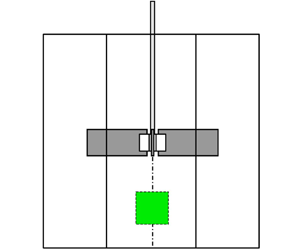Article contents
Two-point statistics in non-homogeneous rotating turbulence
Published online by Cambridge University Press: 16 October 2024
Abstract

Time-resolved two-dimensional two-component particle image velocimetry measurements with high spatial resolution are carried out in a water tank agitated by four blades rotating at constant speed. Different blade geometries and rotation speeds are tested for the purpose of modifying turbulent flow conditions. In all cases where no baffles are used to break the rotation, the Zeman length is an order of magnitude smaller than the Taylor length. Compared with the cases with baffles which break the rotation, in the unbaffled cases turbulence production and/or mean advection are significant and the turbulence nonlinearity is dramatically reduced for the horizontal (i.e. normal to the axis of rotation) two-point turbulence fluctuating velocities. This nonlinearity reduction is manifest not only in the interscale turbulent energy transfer but also in the interspace turbulent energy transfer, which nearly vanishes. However, the nonlinearity is not reduced for the vertical two-point turbulence fluctuating velocities: the corresponding interscale turbulent transfer rate is in fact intensified, and its dependence on the two-point separation distance, as well as that of the corresponding interspace turbulent transfer rate, which does not vanish, is significantly modified. Even though non-homogeneities are very different for different blades and rotation speeds in the unbaffled cases, the horizontal fluctuating velocity's second-order structure function collapses with scalings which resemble predictions for homogeneous turbulence subject to strong rotation. The vertical fluctuating velocity's second-order structure function does not collapse for different blade geometries by neither these nor the Kolmogorov predictions.
JFM classification
Information
- Type
- JFM Papers
- Information
- Copyright
- © The Author(s), 2024. Published by Cambridge University Press
References
- 2
- Cited by


